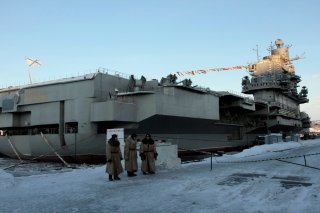Russia Continues to Invest in the World's Unluckiest Aircraft Carrier
Plagued by an increasingly complex and costly set of problems, Russia’s only aircraft carrier is hanging on by a thread.
Here's What You Need To Remember: So vast is the extent of the work that needs to be done on Admiral Kuznetsov that it may prove more cost-effective in the long run to simply procure a new carrier, or—as an increasing number of Russian defense experts are already doing—to ask whether or not the Russian Navy really needs an aircraft carrier in the first place.
Plagued by an increasingly complex and costly set of problems, Russia’s only aircraft carrier is hanging on by a thread.
Classified by the Soviets as a “heavy aviation cruiser,” Admiral Kuznetsov was conceived in the 1980s with a fundamentally different mission from its U.S. counterparts. Kuznetsov was intended as a hybrid mix between a heavy missile cruiser and a dedicated carrier, housing some fixed-wing aircraft whilst acting as a powerful combat platform against American carrier battle groups with its salvo-launched P-700 Granit anti-ship cruise missiles.
Kuznetsov was introduced in 1991 but did not become fully operational until the mid-1990s. Despite suffering several problems involving arguable degrees of human error, the carrier served largely uneventfully through the mid-2010s. It was not until Russia’s 2016 Syrian campaign that the Western world was offered its first glimpse into Kuznetsov’s numerous problems, with the carrier crashing two fighters within less than three weeks of one another.
Russia’s Defense Ministry signed a refit and modernization contract for Kuznetsov in late 2017, but those plans were cut short in the following year when a seventy-ton crane smashed through the ship’s hull and caused its PD-50 drydock to sink. It was estimated that the damage to the ship’s hull would cost as much as one billion dollars to repair, and that’s not considering the price tag of the deep refit and modernization for which Admiral Kuznetsov is long overdue. Then there is the PD-50 itself, which reportedly sustained catastrophic damage during the incident. There were several options available to the military following the drydock disaster, none of them cheap or fast. Moscow initially announced its intent to recover the PD-50 regardless of the colossal costs involved, but those efforts are reportedly being hampered by local corruption and gross industrial mismanagement.
By itself, this sequence of events is more than enough to qualify the Admiral Kuznetsov as one of the world’s unluckiest carriers. But then, things took a truly vaudevillian turn: Kuznetsov caught fire. In December 2019, a fire broke out aboard the ship after a power cable reportedly exploded during routine welding work. Fourteen personnel suffered injuries, and two more died, from the fire and smoke inhalation. Though estimates vary, most sources agree that the fire caused upwards of one billion dollars’ worth of damage. The 2019 fire amplified the worries of some over the mounting costs and questionable benefits of repairing, maintaining, and refitting the carrier. So vast is the extent of the work that needs to be done on Admiral Kuznetsov that it may prove more cost-effective in the long run to simply procure a new carrier, or—as an increasing number of Russian defense experts are already doing—to ask whether or not the Russian Navy really needs an aircraft carrier in the first place.
One might assume that the combined weight of these mishaps would place Admiral Kuznetsov a hair’s breadth away from the scrap heap, but the Kremlin apparently has other plans. Russian officials insist that Kuznetsov will re-enter service by the first half of 2023, replete with electronics, structural, and landing control upgrades, as well as a revamped weapons suite. Russia’s military and civilian leadership appear to have decided that Admiral Kuznetsov is, in a sense, too big to fail, and is willing to make massive investments in order to ensure the ship’s survival into the coming decades.
Mark Episkopos is a national security reporter for the National Interest.
This article is being reprinted due to readers' interest.
Image: Reuters

